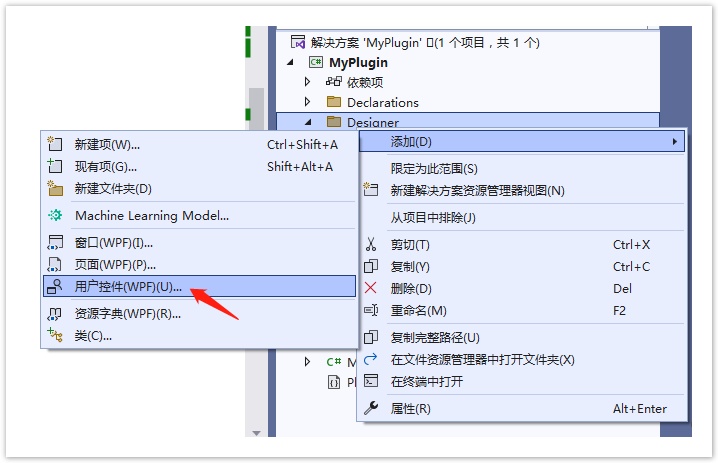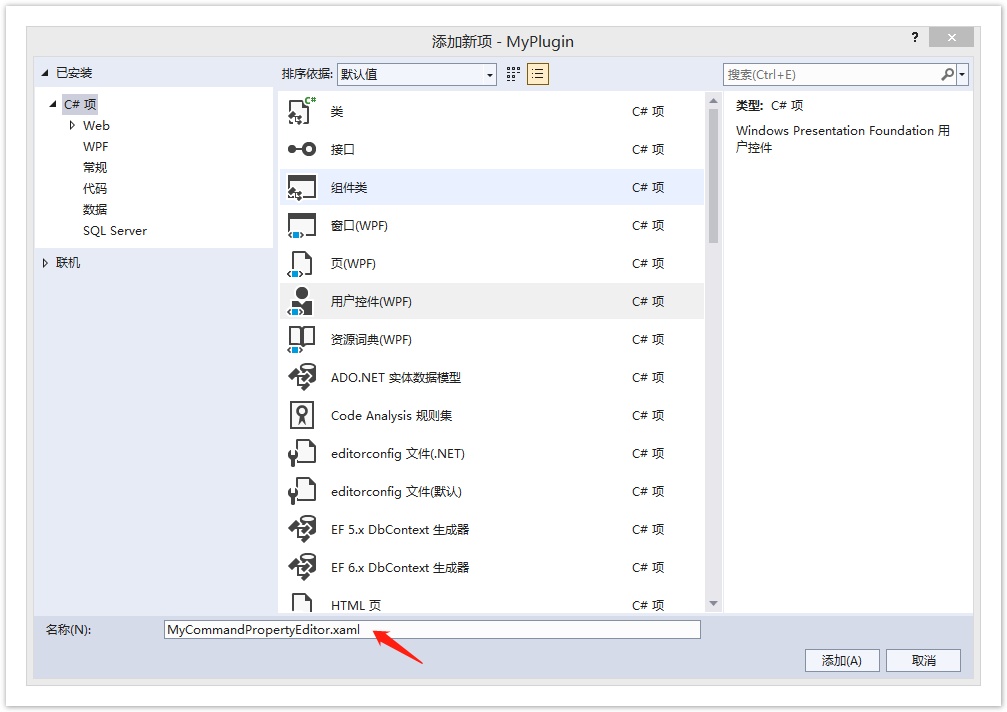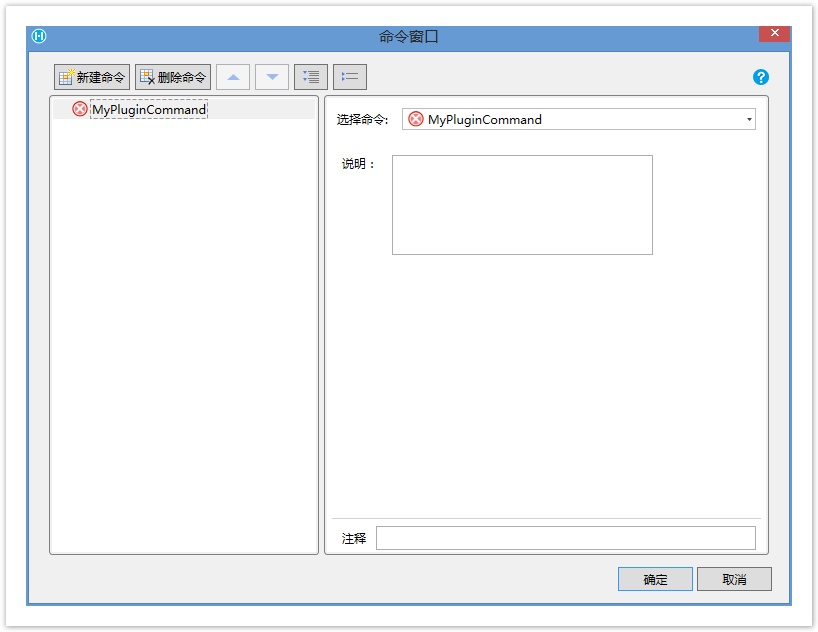大部分情况下,通过标注不同的Attribute给属性,可以指定使用不同的内置属性编辑器。
但是如果希望命令通过更复杂的方式编辑就需要通过自定义一个WPF的用户组件来实现了。
1.在MyPluginCommand中定义一个属性。
[Designer("MyPlugin.Designer.MyPluginCommandDesigner, MyPlugin")]
public class MyPluginCommand : Command
{
[DisplayName("说明:")]
public string MyProperty { get; set; }
}
2.添加一个自定义窗体。
- 在插件工程中Designer文件夹点击右键,选择“添加->用户控件(WPF)”。
- 在弹出对话框中指定名称为 MyCommandPropertyEditor.xaml。
- 创建成功过后分别按以下代码修改 MyCommandPropertyEditor.xaml 和 MyCommandPropertyEditor.xaml.cs 文件。
- 在插件工程中Designer文件夹点击右键,选择“添加->用户控件(WPF)”。
- MyCommandPropertyEditor.xaml 文件
代码说明:在控件中添加了一个多行文本框(可以根据需求加入其它控件)。
- MyCommandPropertyEditor.xaml 文件
<UserControl x:Class="MyPlugin.Designer.MyCommandPropertyEditor"
xmlns="http://schemas.microsoft.com/winfx/2006/xaml/presentation"
xmlns:x="http://schemas.microsoft.com/winfx/2006/xaml"
xmlns:mc="http://schemas.openxmlformats.org/markup-compatibility/2006"
xmlns:d="http://schemas.microsoft.com/expression/blend/2008"
xmlns:local="clr-namespace:MyPlugin.Designer"
mc:Ignorable="d"
MinHeight="100" d:DesignWidth="800">
<Grid x:Name="root">
<TextBox VerticalContentAlignment="Stretch" Margin="9,0,0,0" AcceptsReturn="True" Text="{Binding Text}"></TextBox>
</Grid>
</UserControl>
- MyCommandPropertyEditor.xaml.cs 文件
代码说明:MyCommandPropertyEditor_DataContextChanged 通过 DataContext 属性可以和属性值互操作。
- MyCommandPropertyEditor.xaml.cs 文件
using GrapeCity.Forguncy.Plugin;
using System.ComponentModel;
using System.Windows;
using System.Windows.Controls;
namespace MyPlugin.Designer
{
public partial class MyCommandPropertyEditor : UserControl
{
public MyCommandPropertyEditor()
{
InitializeComponent();
this.root.DataContext = new MyCommandPropertyEditorViewModel();
this.DataContextChanged += MyCommandPropertyEditor_DataContextChanged;
}
private void MyCommandPropertyEditor_DataContextChanged(object sender, DependencyPropertyChangedEventArgs e)
{
if (this.DataContext is IEditorSettingsDataContext editorSettingsDataContext)
{
this.ViewModel.Text = editorSettingsDataContext.Value?.ToString();
this.ViewModel.PropertyChanged += (o, e2) =>
{
editorSettingsDataContext.Value = this.ViewModel.Text;
};
}
}
public MyCommandPropertyEditorViewModel ViewModel
{
get
{
return this.root.DataContext as MyCommandPropertyEditorViewModel;
}
}
public class MyCommandPropertyEditorViewModel : INotifyPropertyChanged
{
private string _text;
public string Text
{
get
{
return this._text;
}
set
{
if (_text != value)
{
this._text = value;
PropertyChanged?.Invoke(this, new PropertyChangedEventArgs(nameof(Text)));
}
}
}
public event PropertyChangedEventHandler PropertyChanged;
}
}
}
3.修改MyPluginCommandDesigner.cs文件,让控件和属性关联。
using GrapeCity.Forguncy.Commands;
using GrapeCity.Forguncy.Plugin;
using System;
using System.ComponentModel;
using System.Windows;
namespace MyPlugin.Designer
{
public class MyPluginCommandDesigner : CommandDesigner<MyPluginCommand>
{
public override EditorSetting GetEditorSetting(PropertyDescriptor property, IBuilderCommandContext builderContext)
{
if(property.Name == nameof(MyPluginCommand.MyProperty))
{
return new MyEditorSetting();
}
return base.GetEditorSetting(property, builderContext);
}
}
class MyEditorSetting : EditorSetting
{
public override DataTemplate GetDataTemplate()
{
DataTemplate template = new DataTemplate();
FrameworkElementFactory spFactory = new FrameworkElementFactory(typeof(MyCommandPropertyEditor));
template.VisualTree = spFactory;
return template;
}
public override VerticalAlignment LabelVerticalAlignment => VerticalAlignment.Top;
}
}
4.效果:


